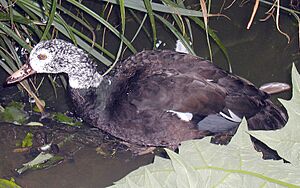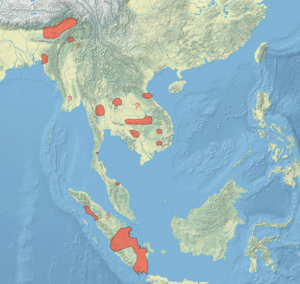White-winged duck facts for kids
Quick facts for kids White-winged duck |
|
|---|---|
 |
|
| At Sylvan Heights Waterfowl Park, North Carolina, United States | |
| Conservation status | |
| Scientific classification | |
| Genus: |
Asarcornis
|
| Species: |
scutulata
|
 |
|
| Synonyms | |
|
Cairina scutulata |
|
The white-winged duck (Asarcornis scutulata), also known as the white-winged wood duck, is a large and special type of duck. It used to be grouped with the Muscovy duck, but scientists now know it's quite different. Studies of its DNA show it's actually more closely related to diving ducks like the redhead. This makes the white-winged duck unique enough to have its very own genus called Asarcornis.
What Does the White-Winged Duck Look Like?
This duck is one of the biggest living duck species, almost as large as the steamer ducks. It can grow to be about 66 to 81 centimeters (26 to 32 inches) long. Its wings can spread wide, from 116 to 153 centimeters (46 to 60 inches) across!
Male white-winged ducks are heavier than females. Males weigh between 2.94 and 3.9 kilograms (6.5 to 8.6 pounds). Females are a bit lighter, weighing from 1.95 to 3.05 kilograms (4.3 to 6.7 pounds).
The most striking thing about these ducks is their dark body. This dark color stands out against their lighter, whitish head and neck. Males have a dull yellowish bill and some dark spots on their head and upper neck. When they fly, you can see their white wing-coverts, which are feathers that cover the main wing feathers. These white parts create a strong contrast with the rest of their dark wings. Females are usually smaller and have more spots on their head and neck. Young ducks are duller in color and browner.
This shy duck usually looks for food at night. It eats a variety of things, including seeds, water plants, grains, rice, snails, small fish, and insects. It prefers to live in calm or slow-moving water areas, like natural ponds or man-made wetlands. These places are usually found inside or next to thick forests. The ducks rely on these forests for safe places to rest and build their nests, often in holes in trees. While they prefer lower areas (below about 200 meters or 650 feet), they can sometimes be found higher up, even at 1,400 meters (4,600 feet), especially near slow rivers and pools on high plateaus.
Where Do White-Winged Ducks Live?
In the past, white-winged ducks were found across a large area. This included northeastern India, Bangladesh, and all the way through South East Asia to Java and Sumatra. Sadly, they are now completely gone from Java.
Today, in India, you can only find them in the northeastern part of the country. Most of them live in eastern Assam and nearby areas of Arunachal Pradesh. In 2002, there were only about 800 white-winged ducks left in the world. About 200 were in countries like Laos, Thailand, Vietnam, and Cambodia. Another 150 lived on Sumatra, especially in Way Kambas National Park. The largest group, about 450 ducks, was found in India, Bangladesh, and Burma.
It's believed that this duck might no longer exist in Malaysia.
In India, some important protected areas for the white-winged duck include Dibru-Saikhowa National Park, Dihing-Patkai Wildlife Sanctuary, Nameri National Park, and Namdapha National Park. These ducks live in dense tropical evergreen forests, close to rivers and swamps.
Why Are White-Winged Ducks Endangered?
The white-winged duck is in danger for several reasons. They like to build their nests in holes inside trees. When these hollow trees are cut down or destroyed, the ducks lose their nesting spots. Also, wetlands and rivers are being drained and changed, which means the ducks are losing the places they need to live. This is called habitat destruction.
Other threats include:
- Loss of variety: There are so few ducks left that they don't have much genetic diversity, which can make them less healthy.
- Disturbance: People bothering them in their natural homes.
- Hunting: People hunt these ducks for food.
- Collecting: Their eggs and young chicks are sometimes taken for food or to be kept as pets.
Because their homes are disappearing, their population is small, and they are hunted, the white-winged duck is listed as Endangered on the IUCN Red List of Threatened Species. This list tells us which animals are at high risk of disappearing forever. They are also protected by an international agreement called CITES, which controls the trade of endangered animals.
Interestingly, some white-winged ducks have been seen living in large tree plantations in Sumatra, Indonesia. These plantations grow a type of tree called Acacia. The ducks often hang out along the canals in these plantations. The large Acacia trees provide shade and cover from predators, and the quiet water in the canals gives them a peaceful place to feed and rest away from people who might hunt them or collect their eggs. Nearby natural forests also offer good places for them to nest and roost.
The white-winged duck is a very special bird to the Indian state of Assam. It is the official state bird of Assam.
There have been efforts to help these ducks by breeding them in captivity, for example, in England. It has been found that they do well in shady, dimly lit areas. However, there's also a higher chance for them to get a disease called avian tuberculosis in these conditions.





